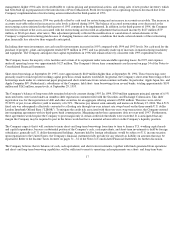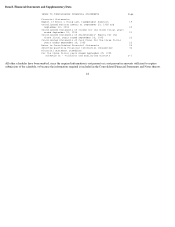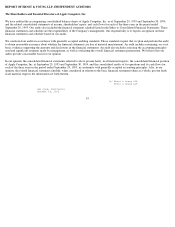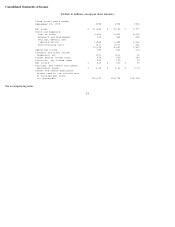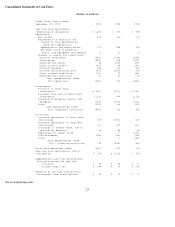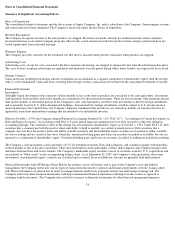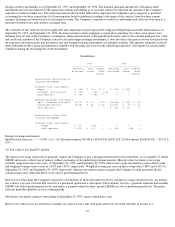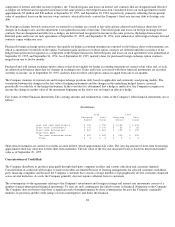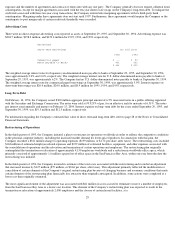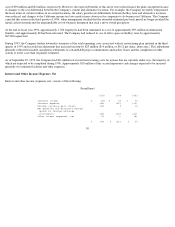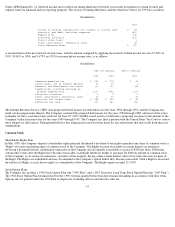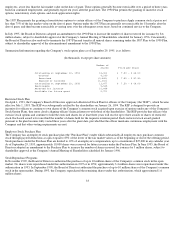Apple 1995 Annual Report Download - page 27
Download and view the complete annual report
Please find page 27 of the 1995 Apple annual report below. You can navigate through the pages in the report by either clicking on the pages listed below, or by using the keyword search tool below to find specific information within the annual report.Gains and losses on accounting hedges of existing assets or liabilities are included in the carrying amounts of those assets or liabilities and are
ultimately recognized in income as part of those carrying amounts. Gains and losses related to qualifying accounting hedges of firm
commitments or anticipated transactions are also deferred and are recognized in income or as adjustments of carrying amounts when the
hedged transaction occurs. Realized and unrealized gains and losses on interest rate and foreign exchange contracts that do not qualify as
accounting hedges are recognized quarterly as a component of interest and other income (expense), net.
The Company monitors its interest rate and foreign exchange positions daily based on applicable and commonly used pricing models. The
correlation between the changes in the fair value of hedging instruments and the changes in the underlying hedged items is assessed
periodically over the life of the hedged instrument. In the event that it is determined that a hedge is ineffective, the Company recognizes in
income the change in market value of the instrument beginning on the date it was no longer an effective hedge.
Interest Rate Derivatives
The Company enters into interest rate derivative transactions, including interest rate swaps and options, with financial institutions in order to
better match the Company's floating-rate interest income on its cash equivalents and short-term investments with the fixed-
rate interest expense
of its long-term debt. These instruments are also used to diversify a portion of the Company's exposure away from fluctuations in short-term
U.S. interest rates. The Company may also enter into interest rate contracts that are intended to reduce the cost of the interest rate risk
management program.
Foreign Currency Instruments
The Company enters into foreign exchange forward and option contracts with financial institutions primarily to protect against currency
exchange risks associated with certain firmly committed and certain other probable, but not firmly committed transactions. The Company's
foreign exchange risk management policy requires it to hedge a majority of its existing material foreign exchange transaction exposures.
However, the Company may not hedge certain foreign exchange transaction exposures that are immaterial either in terms of their minimal U.S.
dollar value or in terms of their high correlation with the U.S. dollar.
Probable, but not firmly committed transactions comprise sales of the Company's products in currencies other than the U.S. dollar. A majority
of these non-U.S. dollar-based sales are made through the Company's subsidiaries in Europe, Asia (particularly Japan), Canada, and Australia.
The Company also purchases foreign exchange option contracts to hedge certain other probable, but not firmly committed transactions. The
Company also sells foreign exchange option contracts, in order to partially finance the purchase of foreign exchange option contracts used to
hedge both firmly committed and certain other probable, but not firmly committed transactions. In addition, the Company enters into other
foreign exchange transactions, which are intended to reduce the costs associated with its foreign exchange risk management programs. The
duration of foreign exchange hedging instruments, whether for firmly committed transactions or for probable, but not firmly committed
transactions, currently does not exceed one year.
For further information regarding the Company's accounting treatment of its investments and other financial and derivative instruments, refer to
pages 26 - 28 of the Notes to Consolidated Financial Statements.
Income Taxes
The income tax provisions for 1995 and 1994 have been determined in accordance with statement of Financial Accounting Standard No. 109
("FAS 109"), "Accounting for Income Taxes," whereby deferred tax assets and liabilities reflect the future income tax effects of temporary
differences between the financial statement carrying amounts of existing assets and liabilities and their respective tax bases. Deferred tax assets
and liabilities are measured using enacted tax rates that apply to taxable income in the years in which those temporary differences are expected
to be recovered or settled. The Company adopted FAS 109 effective the first day of fiscal 1994 on a prospective basis, and the financial
statements of years ended prior to 1994 have not been restated. The cumulative effect of the change was not material. Prior to 1994, the
Company accounted for income taxes under the provisions of APB Opinion No. 11, which recognized deferred taxes for the effect of timing
differences between pretax accounting income and taxable income. Under the deferred method of APB Opinion No. 11, deferred taxes were not
adjusted for subsequent changes in tax rates.
U.S. income taxes have not been provided on a cumulative total of $395 million of undistributed earnings of certain of the Company's foreign
subsidiaries. It is intended that these earnings will be indefinitely invested in operations outside of the United States. It is not practicable to
determine the income tax liability that might be incurred if these earnings were to be distributed. Except for such indefinitely invested earnings,
the Company provides for federal and state income taxes currently on undistributed earnings of foreign subsidiaries.
Earnings per Share
Earnings per share is computed using the weighted average number of common and dilutive common equivalent shares attributable
25




